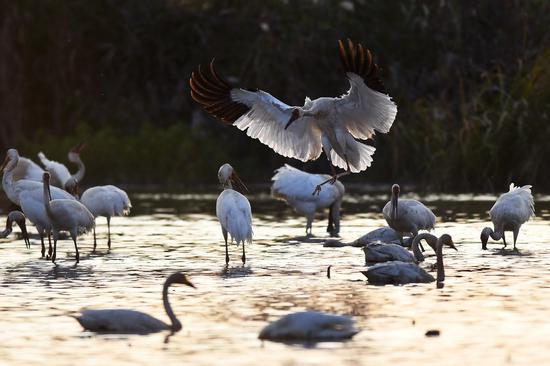
Two crested ibises rest on a branch in Yangxian county, Northwest China's Shaanxi province, in May, 2020. (Photo/Xinhua)
The populations of some endangered wild species in China saw stable growth in the past five years thanks to the country's determined protection efforts, the National Forestry and Grassland Administration said on Monday.
Between 2016 and 2020, China established many nature reserves that now cover 18 percent of its land area and protect 90 percent of the country's plants and 85 percent of its wild animals, the administration said.
"Those nature reserves have played a supportive role in the country's wildlife protection work and also encouraged efforts to reintroduce captive-bred endangered wildlife to the wild," said Zhang Zhizhong, head of its wildlife protection department.
He said that by the end of last year, after decades of steadfast conservation efforts focused on habitat protection, the total giant panda population reached 1,864.
Other endangered wild animals also witnessed steady population growth, including the crested ibis, a bird known as "the oriental gem" that was once thought to be extinct due to the effects of human activities such as urbanization and pollution.
In 1981, Yangxian county in Shaanxi province reported seven wild crested ibises, the only wild population in the world at the time. The population in China has now rebounded to more than 4,000.
To protect the species, commercial logging has been banned in several parts of Shaanxi since 1999 and an environmental protection regulation for the area they inhabit was released in 2007.
China's population of wild Asian elephants-the largest land mammal in Asia and a first-class protected wild animal in the country-has also seen stable population growth, with 300 recorded last year.
Yunnan province, where they live, has established 11 national or regional nature reserves in the tropics since 1958. Those reserves, covering about 510,000 hectares, have provided shelter for elephants.
"Development of artificial breeding technology has also been a key contributor to the stable population growth of some endangered species," Zhang said.
A total of 633 giant pandas have been born through the use of such technology, including 258 in the past five years, the administration said.
Several wild animals that were once extinct in the wild, such as milu deer and wild horses, have now developed their own wild groups thanks to artificial breeding.
Zhang said similar efforts to save the country's endangered wild plants have achieved encouraging results for species including Cycas revoluta (also known as sago palm) and Manglietia sinica, a critically endangered plant endemic to China.
Recent proposals for the 14th Five-Year Plan (2021-25) attached great importance to the protection of natural resources and the environment, indicating the nation's continuing commitment to sustainable development.
"In the past five years, we've spared no efforts to perfect the country's wildlife protection regulation and management rules and hold a strong attitude to crack down on the illegal wildlife trade," Zhang said. "All those efforts will be further strengthened in the future."


















































